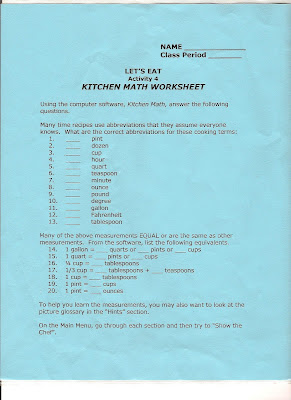After completing today's activities, you will be able to:
---accurately measure dry ingredients for a specific recipe.
---accurately measure liquid ingredients for a specific recipe.
Instructions:
1. Locate the video "The Best of Muffins" on the video rack at the back of the classroom.
2. It is important to watch this video carefully and answer the questions below correctly because at the end of today's activity, you are going to measure the ingredients for tomorrow's baking. Put the FACS header on a clean piece of paper and answer the following questions (the questions are also listed by the TV):
---A. Give three reasons why breakfast is the most important meal of the day.
---B. Name the five food groups in the "Food Guide Pyramid" (now changed to MyPyramid).
---C One muffin counts as one serving from which food group?
---D. List the five steps in baking muffins.
---E. How full should each muffin cup be filled?
---F. What part of the muffin tin should you grease and why?
---G. About how many minutes should muffins bake?
---H. How do you tell when the muffins are done?
---I. How should you store the muffins that are not eaten?
3. Locate the worksheet "Upcoming Events: This Is Your Recipe!" in the blue milkcrate...it will look like the sheet below. Read the recipe below and use it to fill in the blanks...summarizing in your own words. (Double click on the image to enlarge it so you can read it.) This must be completed for you to cook tomorrow.


4. Go to the measuring station that is set up for you. Measure the dry ingredients you will need when making tomorrow's muffins
---A. Measure and place the sugar in a plastic bag and lable with your names.
---B. Measure only the flour, baking powder, salt, and baking soda and place in bag with your names.
---C. Ask your teacher for a bag of poppy seeds if you are making the banana poppyseed muffins.
---D. Put your plastic bags in a bowl and place it in the back refrigerator.
6. Go to www.mygradebook.com and take the Let's Eat Possttest...it does count as a grade.
7. If you have time, locate the sheet "Unit Pricing" at the end of this activity. When it comes to food, there are any good bargains to be found by a "good" shopper. Unit pricing of food helps that shapper get the best deal. Number the same paper 1 to 5. Read the instructions explaining how to calculate unit prices on the Unit Pricing instruction sheet. Then work the problems to see which is the best deal.
 8. Find the worksheet "Shopping for Bargains" and answer those question on your video answer sheet.
8. Find the worksheet "Shopping for Bargains" and answer those question on your video answer sheet. 9. Place all your work in your numbered notebook and hand the "Upcoming Events" sheet to your instructor.
9. Place all your work in your numbered notebook and hand the "Upcoming Events" sheet to your instructor.10..Clean your module area up. Make sure the kitchen you measured in has all the utensils correctly placed and the countertops clean.
Materials:
Pen/Pencils
Paper
Equipment:
TV/VCR
Kitchen
Computer
Instructional Materials:
Video "The Best of Muffins"
Worksheets "Upcoming Events: It's Your Recipe", "Unit Pricing" and "Shopping for Bargains"
Guidesheets Banana/Poppyseed Muffin Recipe and Blueberry Muffin Recipe


